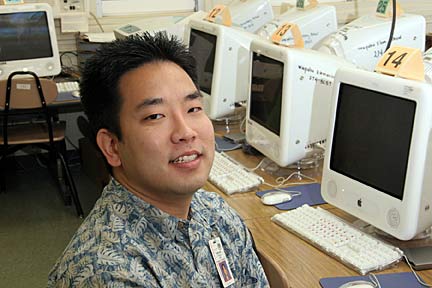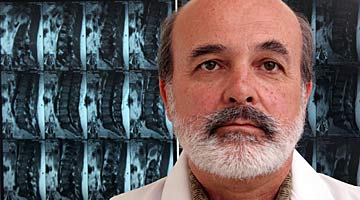
A surfer looks over his shoulder at Canoe's in Waikiki. Medical research has shown that some first-time surfers suffer a form of paralysis from frequently looking over their shoulders.
Straub neurologist sees
pattern of paralysis
For first-time Waikiki surfers,
repeatedly arching the back for
hours in rare instances restricts
blood to the spine
Sherwin Hiraoka said he had "the time of my life" when he rented a longboard and surfed for the first time at Waikiki Beach.
INFO WANTED
Dr. James Pearce would like to hear from anyone who thinks he or she had surfer's myelopathy after the first time out on the board. Call 522-4476.
|
Hiraoka, now 26, didn't have an accident during his August 2002 outing, yet he still suffered a rare spinal-cord injury that Straub Clinic & Hospital doctors have named "surfer's myelopathy."
Dr. James Pearce, a Straub neurologist, said the potentially debilitating injury is associated with first-time surfers. Pearce sees several cases a year and said the patients all come from Waikiki and have a similar story.
"A person would have a surfing lesson the first time, go out in the surf and be out on the long side, one or two hours," he said.
While on the water or on their way back to shore, they started to feel pain in the back and weakness or numbness in the legs. Some collapsed on the beach, he said.
About 80 percent of the patients have recovered fully, Pearce said.
But some, such as a vacationing medical student who is the son of a neurologist in Japan, remain paraplegic, he said. "It's totally tragic."
Pearce, who frequently works in Straub's emergency room, said he first noticed the unusual condition in one or two cases in the late 1980s. He began documenting what was happening and asked other doctors to keep an eye out for similar cases.
"In a year or year and a half, it became clear that we were seeing a very specific syndrome," Pearce said.
He and his colleagues reported on nine patients with surfer's myelopathy between June 1998 and January 2003 in the August issue of the SPINE journal. The average age was 25.
Many of the first patients were slimly built male Japanese nationals and he thought the injuries might be related to their build, he said. Yet other patients had strong builds, he said. One man was a nurse and rock climber in Colorado who didn't recover, he said.
He has seen only about three local patients, including one woman.
Pearce believes the injuries to neophyte surfers are caused by repeatedly hyperextending or arching their back off the board looking for waves and preparing to catch a wave.
"They're not used to it. They hyperextend their back a lot of times and they happen to have the kind of build that predisposes them to a temporary problem with the blood flow to the spinal cord.
"They do it again and again and again, so the lower part of the spinal cord is impaired because of temporary but repeated problems of blood flow to that area."

Beginning surfers test their skills at the Waikiki break Canoe's. Recent medical research has shown that some surfers have experienced a form of paralysis from restricted blood flow to the spine.
Of those patients with surfer's myelopathy who were tracked by Straub doctors in 1998-2003, three completely recovered at the time of discharge, one was paraplegic, and five others had mild medical problems.
Pearce continues to document cases and estimates he sees four or five new patients a year with the rare syndrome.
He said it may be occurring elsewhere but has never been reported.
"The only reason we have been able to recognize it and collect cases is there is no place in the world where so many people get surfing lessons in just one spot," he said.
Jesse Juan, 39, general manager of Hans Hedemann Surf Hawaii, said beginning surfers are taught basics on land for 10 or 15 minutes, then they're in the water for 1 1/2 hours.
He said he has surfed all his life and worked in the industry 15 to 20 years and has never heard of any first-time surfers with spinal-cord injuries. "It might be a posture thing; maybe they don't sit correctly," he suggested.
Kim Ball of High Tech Surfing Sports on Maui, organizer of the island's scholastic surf championships and father of three surfing sons, said he knows people sometimes get sore backs from arching on the board.
But he said he's never heard of the injuries that Pearce has identified among first-time surfers. "This goes to show, any time the body is in an unfamiliar position and you push it and go too far, you risk injuries," Ball said.
Hiraoka said he didn't have a surfing lesson, but "learned by watching and (had) some advice" before going out on Aug. 31, 2002.
After being in the water about 45 minutes, he got out and noticed that his hips and lower back were sore. "I didn't think anything about it at first because I just thought it may have been a muscle strain."
When he got home that afternoon, he noticed his legs getting numb. "Again, I didn't think anything of it so I took a shower and decided to sleep and rest my back.
"Then the shock of my life happened. I woke up and tried to stand up but my legs would not respond."

Sherwin Hiraoka, shown at his part-time technology coordinator job at Waipahu Elementary school, lost the use of his legs the morning after his first surfing experience. Dr. James Pearce, a neurologist at Straub Clinic & Hospital, noted that first-time surfers can experience pains and numbness and even a few became paraplegic.
When admitted to the hospital, Hiraoka said he was given a steroid to reduce inflammation of his spinal cord and had an allergic reaction. He was hospitalized seven days.
"Slowly, day to day I started to get feeling back into my legs," he said.
Hiraoka started walking with a walker in four or five days and in another week was able to walk unaided for short distances.
He said Pearce prescribed physical therapy after leaving the hospital but after sessions twice a week for three weeks "it was still a challenge to walk and drive."
Hiraoka began practicing judo about five months after the accident but can only do techniques that don't cause his back to hyperextend, he said. "I feel hopeless at times, but I just have to live with it."
He teaches judo three times a week at Sogoro Judo Club and coaches the Roosevelt High School judo team with his father, mother and girlfriend.
His right leg still is weak and his back acts up in cold temperatures, making it difficult to lift his legs, he said. He went back to bike-riding to lose weight and lessen the strain on his lower back and thinks judo and bike-riding are making his legs stronger.
Hiraoka is enrolled in the Information Technology Management program at the University of Hawaii-Manoa College of Business and works part-time at Waipahu Elementary School as technology coordinator.
He hopes his experience will alert other first-time surfers to the potential risks. "As I recall, I'm one of the lucky ones that actually got back most of my lower body functions."
www.straubhealth.com/
The Spine Journal
www.journals.elsevierhealth.com/periodicals/spinee
Myelopathy signs
|
[News] [Business] [Features] [Sports] [Editorial] [Do It Electric!]
[Classified Ads] [Search] [Subscribe] [Info] [Letter to Editor]
[Feedback]

